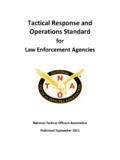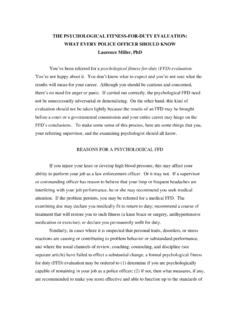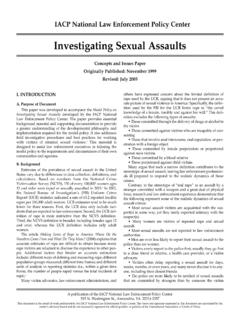Transcription of Deviance and Corruption
1 Deviance and Corruption9 CHAPTER131 IntroductionDevianceis an action or behavior that violates the generally accepted normsof a group, organization, or society (Adler, 2005). Many societies and orga-nizations policies, practices, and laws are developed from this normativefoundation. Policies (and sometimes laws) are written because entities, rang-ing in size from organizations to countries, codify acts of Deviance . Deviancecan and does occur in all workplaces and throughout all professions. Whenpublic officials violate organizational rules and/or break the law these actsare also called malfeasance, misfeasance, and nonfeasance. Yet the scholarlyliterature typically prefers to use the term criminal justice agencies have codes of ethics or standards of con-duct that are taught to recruits and reinforced by veterans of the organiza-tion.
2 One term closely related to Deviance is Corruption , also known as to McCarthy (1996), this practice includes the intentional viola-tion of organizational norms ( , rules and regulations) by public employ-ees for personal material gain (p. 231). This behavioral category subsumestheft, smuggling contraband, embezzlement, and misuse of authority(p. 232). Corruption , however, is not a synonym for Deviance , although it isa subset of this Deviance occurs when law enforcement officers behave in a mannerthat is inconsistent with the officer s legal authority, organizational authority,and standards of ethical conduct (Barker and Carter, 1986, pp. 2 3). police Deviance includes but is not limited to: discrimination misconduct intimidation sexual harassment Corruption excessive force use of restricted weapons illegal surveillance 12/9/10 10:02 AM Page 131132 Chapter 9 Deviance and CorruptionThis chapter reviews how widespread Deviance is in police departmentsin the United States.
3 It will also present a typology of police Deviance , intro-duce the research methods that scholars use to conduct studies on policecorruption, and examine the causes and effects of Deviance (particularly thecontrols on Corruption ).1 How Widespread Is the Problem?It is hard to determine how much Deviance exists in specific police depart-ments, which makes it almost impossible to gauge the pervasiveness ofdeviance across the country. One thing keen observers can be sure of is thatbecause of the numerous policies, procedures, and rules that exist in policeagencies, most officers have at one point or another in their career violatedat least one of the violations are minor in nature for example, officers not wearingtheir hats when required to do [E]ven the more serious deviations arewidespread and frequent occurrences. Examples would be some form ofunnecessary verbal or physical abuse, misrepresenting or leaving out facts inpolice reports, committing perjury when testifying in court, or violatingimportant organizational policies, such as those governing high-speed In fact, such behavior is so common in many agencies that it hasbecome the way of doing business and is no longer considered seriousenough to warrant a formal organizational response.
4 (Roberg and Kuykendall,1993, p. 186) Typology of police Deviance In general, police Deviance can be divided into two types: occupationaldeviance, which involves criminal and noncriminal [behavior] committedduring the course of normal work activities or committed under the guise ofthe police officer s authority (Barker and Carter, 1986, pp. 4 7), and abuseof authority, which involves the violation of the trust placed in Deviance usually falls under the categories of corruptionand misconduct. The abuse of authority includes any action by a policeofficer without regard to motive, intent, or malice that tends to injure, insult,trespass upon human dignity, manifest feelings of inferiority, and/or violatean inherent legal right of a member of the police constituency in the courseof performing police work ( , physical, psychological and legal abuse) (Roberg and Kuykendall, 1993, p.)
5 186). There are two subcategories ofoccupational Deviance : police misconduct and police Corruption . Policemisconduct involves violations of organizational policies, procedures, rules,and other standards, whereas police Corruption covers any criminal act inthe commission of one s job, which benefits either the officer in question orsomeone else. 12/9/10 10:02 AM Page 132 Typology of police Deviance133 police GratuitiesOne of the most frequent problems commonly confused with Corruption isthe solicitation or acceptance of gratuities by police officers. A gratuity issomething of minor value a cup of coffee, for example, or other gift orsmall reward offered as a token of appreciation in return for non-enforcement of a criminal law. Accepting gratuities is a common practicein many police departments, but this practice is considered to be unethicalby influential police organizations, such as the International Association ofChiefs of police (Roberg and Kuykendall, 1993, p.
6 187). Even though apolice agency may have a written policy against the acceptance of gratuities,a disproportionate number of its rank and file ignore this rule. There are both positive and negative issues involved in accepting gratu-ities. On the positive side, for example, business owners may believe that apolice presence minimizes the possibility of victimization by shoplifters orjuveniles. The gratuities also may reflect business owners and managers appreciation for police officers. The general public also may not be aware ofthe problematic nature of giving police gratuities. Refusal of an offer maysometimes be interpreted as an the negative side, gratuities may compromise a police officer s abilityto operate in a democracy in a balanced and fair fashion (Roberg andKuykendall, 1993, p. 188). In other words, police officers may be in dangerof granting preferential treatment to those who give gratuities and thus applythe law unequally.
7 Acceptance of gratuities may even result in police offi-cers thinking of themselves as special in the sense that they deserve benefitsthat others do not (p. 188). Critics of the acceptance of gratuities also thinkthat this may lead to more serious forms of Corruption (p. 188). Regardless of one s personal opinion, one must take into considerationthat Deviance is situational, meaning that in one police department, a behav-ior can be interpreted as normative, while in another it is perceived asdeviant. This relativity is especially pronounced in the use of profanity,sleeping ( , cooping ) on the job, and engaging in personal business ( ,going to the bank) while on duty. CorruptionAs stated earlier, police Corruption , the second subcategory of occupationaldeviancy, involves overt criminal activity by police officers.
8 This includescommitting crimes like theft or robbery, selling drugs, or taking money orsomething of value to not enforce the law (Roberg and Kuykendall, 1993,p. 190). These types of actions are known among police officers as going onthe pad, collecting a steady note, or collecting the rent (Barker, 1977). police officers may receive money or other items of value, both legal andillegal, in exchange for not citing or arresting an individual for prostitution,illegal gambling, or drug possession or for Corruption have existed for a long time. As Fogelson (1977)commented, during the political era, the police did not suppress vice; 12/9/10 10:02 AM Page 133134 Chapter 9 Deviance and Corruptionlicensed it (p. 32). Throughout the country, they permitted gamblers,prostitutes, and saloon keepers to do business under certain well understoodconditions.
9 These entrepreneurs were required to make regular payoffs tothe police (Roberg and Kuykendall, 1993, p. 192). Some jurisdictions, likeNew York City, have a long history of police Corruption . Over the history ofthe NYPD, at least nine major Corruption investigations have been exposedand is the difference between Corruption and bribery? In short, briberyinvolves the acceptance or solicitation of bribes and gratuities (which usu-ally involve money or some sort of economic benefit, gift, or favor) inexchange for past, current, or future actions that will benefit the individualor organization that gives the bribe. Types of police CorruptionCorruption is a broad and varied issue. Examples include: Corruption ofauthority ( , through the offering of free meals and drinks especiallyalcohol services, or discounts); kickbacks (money, goods, and services);opportunistic threats (victims, burglary, or unlocked buildings); shakedownsof criminals; protection of illegal activities (vice operators, business people);traffic citation fixes; misdemeanor or felony charge fixes; direct criminalactivities (burglary, robbery); and internal payoffs (off-days, work assign-ments).
10 Some experts have rank-ordered the seriousness of different kinds ofcorruption (Caplan and Murphy, 1991).In general, corrupt officers can be divided into two types. On the onehand, so-called grass eaters are officers who engage in minor ( , low-level) Corruption . These kinds of actions are usually reactive and are gener-ally not frowned upon by other officers. On the other hand, meat eaters are police officers who actively engage in crimes, including burglary anddrug dealing, on a regular basis. These officers are proactive in their endeav-ors. police departments commonly protect reactive grafters but not proactivegrafters. Meat eaters are usually ostracized by other police officers may accept low-level bribes, which they call cleangraft, but they usually refuse to take drugs or money from drug dealers,which they consider dirty graft.















